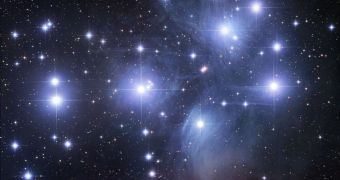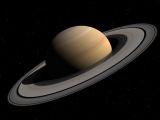The night sky will entertain us this month with a splendid combination of stars, complemented by the Moon and Saturn. Starting with 8 April, star gazers will be able to view the Pleiades star cluster rising above the western skies after the sunset, as the Moon passes through the first quarter, the full moon phase and third quarter. While the Moon is very bright in this year period, shadowing most of the bright stars in its vicinity, it passes just below the Pleiades star cluster, enabling star lovers to view it without the help of professional tools.
Known since the ancient times as the Seven Sisters, the Pleiades star cluster is often identified, throughout the world, with the image of a group of women. Saturn, on the other hand, will be present in the southeastern region of the sky, high above the horizon, appearing as a star passing through the vicinity of the brightest star in the Leo constellation, Regulus. Although Saturn is now passing through a 'ring plane crossing' stage, during the month of April its rings will actually open slightly. By the end of the year, its rings will be edge-on and will become invisible for observation from the surface of Earth.
On April 2 and 18, respectively April 10 and 26, Saturn's largest moon Titan will be visible from Earth, in the southern regions of the planet, respectively in the north. Also Jupiter will make its appearance on the sky at 3 a.m. LDT, so that by the end of the month it will rise two hours earlier. It will appear high above the horizon in the southern regions of the sky, enabling the view of its four largest moons only with the help of a pair of binoculars.
They would look like small bits of white light that change their position in relation to Jupiter from night to night. If you are not able to find them, it is most likely that they are either eclipsed by the planet or passing in front of it on their orbits.
Mars will pass through the Gemini constellation during the month of April, acquiring a bright orange tint in the process. Its close approach to the Pollux star will give you a good chance of comparing their colors. Don't forget about the binoculars!
Mercury, on the other hand, will be invisible for most of April for observers in the northern hemisphere. At the end of the month, it will finally escape the Sun's glare and appear in the west-northwestern regions of the sky, just below the Pleiades. Those of you located in the southern hemisphere of the Earth will be able to spot it in the early hours of the morning.
Similarly, Venus will also be invisible for most of the month, as it is located to the other side of the Sun. Only by July, it will start to regain its position in the western regions of the sky. Observers in the southern hemisphere will be able, however, to get a quick peek at Venus, an hour and a half before the sunrise.
Lyrid meteor shower
The coming of April also brings us the Lyrid meteor shower, which is expected to reach its culmination during 21-22 April. The meteors will seem to radiate from a location in the sky in the constellation Lyra the Harp, near the star Vega and should reach about 20 meteors per hour, although the high brightness of the Moon will hide few of the faintest ones.
Announcing summer
The so-called summer triangle consists of three bright stars, namely Vega, Altair in the constellation Aquila the Eagle, and Deneb in the constellation Cygnus the Swan. Vega is to appear first from the east and will raise high in the sky. In fact, when you are looking from Deneb to Altair, you should also be able to view the Milky Way galaxy, but light pollution will most likely obscure it. So find yourself a nice dark sky, away from the city lights, take the binoculars with you, and enjoy!

 14 DAY TRIAL //
14 DAY TRIAL // 
